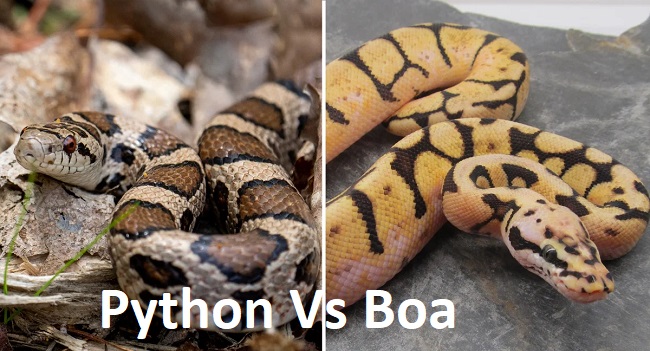Pythons and Boas are among the most iconic representatives of the snake world. These large constrictors captivate snake enthusiasts with their sheer size, strength, and fascinating behaviors.
However, despite certain similarities, Pythons and Boas differ significantly in various aspects, such as geographical distribution, physical characteristics, and reproductive methods.
This comprehensive guide aims to delve deep into the Python Vs Boa discussion, shedding light on their unique characteristics and captivating life histories.

Geographical Distribution: Python Vs Boa
Pythons and Boas can be found in different parts of the world, reflecting their adaptation to distinct environments. Pythons are primarily found in Africa, Asia, and Australia, favoring tropical, subtropical, and rainforest environments.
In contrast, Boas inhabit a wider range of habitats, spanning across North, Central, and South America, as well as parts of Africa, Asia, Europe, and some Pacific islands.
They can adapt to various environments, including deserts, tropical rainforests, savannas, and even the cold highlands of the Andes.
Read Also:
Physical Characteristics: Spotting the Differences
Both Pythons and Boas are known for their size, being among the world’s largest snake species. However, there are key differences that can help you distinguish between the two. In terms of size, both vary greatly depending on the species.
The reticulated Python, the world’s longest snake, can grow over 20 feet long. Similarly, the green anaconda, a species of Boa, is known for its immense weight and girth, despite not being the longest.
One distinguishing characteristic is the presence of pelvic spurs, which are the remnants of hind legs from their evolutionary past. While both Pythons and Boas possess these spurs, they are typically more prominent in Boas.
Their head shape and scale configuration also differ. Pythons generally have a more elongated head with many small scales, while Boas have a more triangular head with fewer, larger scales.
Reproductive Differences: Oviparous Vs Ovoviviparous
One of the most significant differences between Pythons and Boas lies in their reproductive methods. Pythons are oviparous, meaning they lay eggs.
The female Python often coils around her clutch, providing heat through muscular contractions in a rare display of parental care among snakes.
Boas, on the other hand, are primarily ovoviviparous, which means they give birth to live young. The eggs develop and hatch within the female’s body, and the young emerge fully formed. This adaptation can offer the young a better survival rate, as they are less exposed to predators.
Behavior and Lifestyle: Python Vs Boa
While both Pythons and Boas are non-venomous constrictors, preferring to squeeze their prey, their hunting and lifestyle behaviors can vary due to their differing environments.
Some Pythons, like the African Rock Python or the Reticulated Python, are known for their aggressive nature when threatened.
Boas, on the other hand, are generally more docile, but behaviors can differ greatly among species.
Key Takeaways
Pythons and Boas differ in geographical distribution, with Pythons found primarily in Africa, Asia, and Australia, while Boas inhabit a broader range of habitats across multiple continents.
Both snake groups display vast size differences depending on the species, with reticulated Pythons known for their length and green anacondas recognized for their weight.
Pythons and Boas can be differentiated by physical characteristics such as head shape, scale configuration, and the prominence of pelvic spurs.
A significant difference lies in their reproductive methods, with Pythons being oviparous (egg-laying) and Boas being primarily ovoviviparous (giving birth to live young).
Both Pythons and Boas employ constriction as their hunting method, but their behaviors can vary significantly due to differing environments and species-specific traits.
Read Also:
Conclusion
The world of Pythons and Boas is filled with fascinating differences and intriguing similarities. From geographical distribution to physical characteristics and reproductive methods, these captivating creatures offer a wealth of knowledge about adaptation and survival strategies.
Whether it’s the Python’s remarkable egg-incubating behavior or the Boa’s adaptation of giving birth to live young, both these serpent groups add to the rich tapestry of nature’s biodiversity.
























